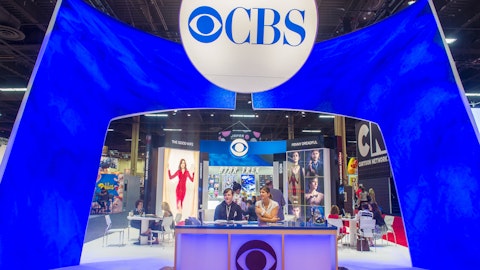But if you look at the investor deck and see what we’ve been able to do in free cash in political years, I think it will be very instructive to everyone.
Steven Cahall: Thanks, Jim. And maybe to follow-up on that political theme, this could be for Jim or for Pat. I think your guidance for Q3 in political is lower than what you did pro forma in 2019. Is that just some conservatism after some of the more dynamic nature of political spending? And maybe related to that, Pat, how many political impressions do you pick up in core in the back half of the year? Because I imagine that’s a pretty big tailwind given the level of crowd out you had last year?
Pat LaPlatney: It’ll definitely — it will be impactful in September, October in terms of crowd out. You’re right, we are being conservative and for obvious reasons. Obviously, the Former President is a huge wildcard and his situation, I think sort of dictates conservatism. So it could churn out significantly better or it could fall into a wide range, but I think — particularly in October of last year, there was a significant sort of crowd out factor September and October?
James Ryan: Yes. But obviously, if you look at — Steven, again, if you’re comparing to ’19, yes, we’re probably a little more conservative. As Pat said, there’s probably a reason to be. We’ve obviously had an extremely strong first half performance. We started the year with a political guide. I’d have to go back and look, but I think it was closer to $40 million in the current $60 million guide. So certainly, our expectations have been improving as we’ve gone. I think again, keeping in mind that this year is — except for the early President — ’24 Presidential money, it is a traditional off year. Traditional off year is progressing kind of like we would expect it to. I don’t think any of us have seen any major red flags yet there.
And as Pat said, the wildcard in political, whether it’s Q3 or Q4 is going to be — what happens with the early ’24 especially the early primary states, we certainly expect that we will be getting more money on the early primary states as we go through the latter part of the year because we’re very strong positioned in those states. We’ll kind of let the numbers take care of themselves. All in all, for a nonpolitical year, and we’ve commented about unimaginable early political spend in ’23 going into ’24 for the ’24 Presidential cycle. At the end of the day, we think political for ’23 is an off year is going to take care of itself.
Steven Cahall: Thank you. And then maybe just the last one for Kevin. We do kind of our own sub counts and forecast as well in your low single-digit number certainly sounds better than ours. I think some of the delta may be Paramount Plus and Peacock, which I know you do get paid on for your stations as well. So number one, is that correct in terms of the way you’re doing your sub counts? And is there any way to think about the impact of Paramount Plus and Peacock within that low single-digit rate that trend now? Thank you.
Kevin Latek: Steven, we have always, always included every distributor who pays us a fee for the linear distribution of our signals as a distributor when we do subscriber counts, and we have always counted a subscriber with Paramount Plus before that CBS Access when we count subscribers. We are getting paid a monthly fee for sub for the 24×7 distribution of our signal. So we have never excluded them, and I don’t see a reason to exclude them otherwise. In terms of magnitude of Paramount Plus and Peacock, I’m concerned about giving that percentage out. We’ve been asked I think every call for that. We’re not supposed to be disclosing the sub numbers for any distributor, and we provide the combined number. I think it provides a fairly easy roadmap for people to figure out what Paramount Plus numbers are, and we’re not prepared to do that.
We are the biggest CBS affiliate. And so you can presume that between Peacock and Paramount Plus, it’s Paramount Plus is a very large part of that, and Peacock is a fairly small part of that.



